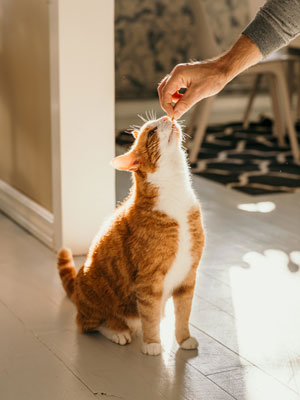
October 01, 2020
Unlock the feline mind (or how to train your cat)

Talking about unlocking the feline mind basically means talking about learning, said Dr. Debra F. Horwitz, veterinary behaviorist.
Dr. Horwitz, who owns Veterinary Behavior Consultations in St. Louis, presented the session “Unlocking the Feline Mind” on Aug. 21 at the AVMA Virtual Convention 2020.
“So what is learning?” she asked. “Learning is the relationship between behavior and consequence. You do a response, and there is an outcome. And the future responses that you might make in that same situation are based on the outcome itself.
“The foundation of efficient learning is creating a stimulus-response relationship that leads to learning the correct response.”
Theoretically, teaching cats is no different than teaching dogs. The learning principles are the same across species. Nevertheless, cats may attend to cues differently, eat treats differently, and have different behaviors to change.
The first step is to identify the behavior to change and what the new behavior will look like. A person might not want a cat to meow in the middle of the night, but rather, to sleep quietly on the bed or in another room.
“Behaviors are learned through a stimulus-response-consequence paradigm,” Dr. Horwitz said. People must slowly guide cats through the steps to change behaviors.
With positive reinforcement, the more you do a certain behavior, the more you get, and what you get is good, and so the behavior increases. For cats and dogs, food works really well as a reward, Dr. Horwitz said. For cats, one of the foods that works best is soft treats that can be consumed quickly, such as anchovy paste.
With punishment, the more you do a certain behavior, the more you get, and what you get is bad, and so the behavior decreases or stops. Punishment is not a good teaching tool, Dr. Horwitz said. “Why? Because it just tells you what not to do. It doesn’t tell you what to do.”
Dr. Horwitz discussed various types of learning and gave examples. She trained a cat to get up on his climbing tower and sit there so she could give him his inhaler. First she taught him “up,” and he got up and got some food. Eventually, he learned to take three to five breaths, and then he would get another treat.
Another example involved introducing cats that didn’t like each other. The cats were placed on either side of a door with a rope underneath that had a catnip toy at each end. The cats also were fed at a distance with two stacked baby gates between, and the food was gradually moved closer to the gates.
Dr. Horwitz went on to offer more tips on training, how to handle setbacks and pitfalls, and how to help behavior plans be successful.
The talk was based on one of the chapters of “Decoding Your Cat,” a new book from the American College of Veterinary Behaviorists, with Dr. Horwitz as one of the co-editors. The book is the companion to “Decoding Your Dog” from the ACVB, which came out in 2015.